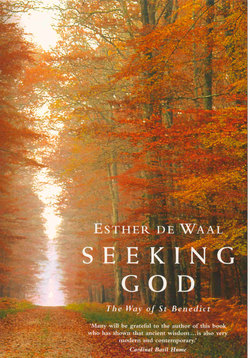Читать книгу Seeking God - Esther de Waal - Страница 9
На сайте Литреса книга снята с продажи.
ОглавлениеEXPLANATION
This book is directly inspired by Canterbury, by the cathedral and the Benedictine community which it housed in the Middle Ages. Seven years ago I had not read the Rule of St Benedict, and had only the most vague idea of what the Benedictine life involved. Like so many Anglicans, I had been aware of this country’s monastic heritage in buildings and works of art. I had grown up as a child in the Shropshire parish where my father was vicar, and the church had belonged to a Benedictine priory whose ruins I saw every day from the vicarage garden. I was simply one of the many who admired abbey ruins and cathedral cloisters for what they said about past greatness. But actually to come and live in Canterbury in the context of that greatness was an entirely different experience. The house in which we lived had been the prior’s lodging in monastic times; the cathedral in which we worshipped had been the church of a Benedictine community numbering among its abbots Lanfranc and Anselm; and we were surrounded by buildings which reflected the life of that community. If I walked out of the front door I passed the granary, the bakehouse and the brewhouse; if I went out by the side gate I walked through the ruins of the infirmary; the view from almost every window was of some different part of the monastery – the scriptorium, the pilgrim’s hostel, and of course the great cathedral church itself overshadowing us all the time.
One day an excavation on the south side of the cathedral, in the area of the monastic graveyard, came upon two skeletons. As they lay there, anonymous, individual and yet corporate, I found myself suddenly confronted with the men whose hands had built this place and whose vision had created its way of life. That encounter led me to read the Rule of St Benedict. I felt that I needed to discover something of the spirit of the Benedictine life if I was to draw strength from it and not feel crushed by what one of our sons had once called, standing under the tower of Bell Harry, ‘the shadow of perfection’.
Sometimes one finds a place, a landscape, which is new and yet the forms, the shapes, the shadows seem already familiar. So it was for me with the Rule. It was neither remote not past nor cerebral, but immediate and relevant, speaking of things that I already half knew or was struggling to make sense of. It tackled with honesty questions of personal relationships and authority and freedom; it recognized the need for stability and the need for change; it established a pattern for a balanced life; its sense of respect and reverence for people and for material things touched me immediately. I valued its insight on such day-to-day matters as hospitality or the attitude towards material possessions. Above all it spoke of a life that was essentially unheroic, much in fact like the life of any ordinary Christian family.
Although I had been thinking about this for a number of years the actual writing of this book has been done in the short space of six months. It has therefore had to take its place in a pattern of life dictated by the demands of the family, by cooking and housework, by Open University tutoring as well as the endless hospitality that we experience in a Canterbury summer when the tradition of pilgrimage still brings great numbers of visitors. This is the life of continuous interruption that I speak of in chapter VI, and often the book has been written at times of constant demands when the one reality to which I held was that promise of the Rule ‘Never to despair of God’s mercy’. So this is not the work of an academic or a theologian. It comes from the lived-out experience of a wife and mother with many commitments, and it springs from a conviction that the Rule speaks to those who like myself are seeking God in the midst of a busy, often confusing and exhausting daily life. I have one hope in writing this book and that is that it may serve as a first step to an encounter with the Benedictine way, for reading about it is no substitute for living it. The Rule is ancient wisdom and yet it is new, as new as the Gospel, for it is towards Christ himself that St Benedict would continually point us. It has in the past fifteen hundred years been the way by which countless Christians living under the vows in a monastic community have found God, but it speaks as well to all those of us struggling to follow our baptismal promises in the world.
Many people and many places have helped me to write this book. It would never have been possible without the support and critical encouragement of my family. I have tried to make due acknowledgement in the notes to the many Benedictine scholars whose works I have read, and if I have failed to mention any I hope I shall be forgiven. My deepest debt is to the communities of St Mary’s West Mailing and Bec Hellouin in Normandy, with whom Canterbury has been linked for so many centuries, though there are many others, both in England and abroad, from whom I have gained insight into the Benedictine life. But in the last resort this book is a very personal attempt to show how the Rule of St Benedict has been an inspiration and a guide to an ordinary lay Christian.
Esther de Waal
Canterbury
25th September 1983
